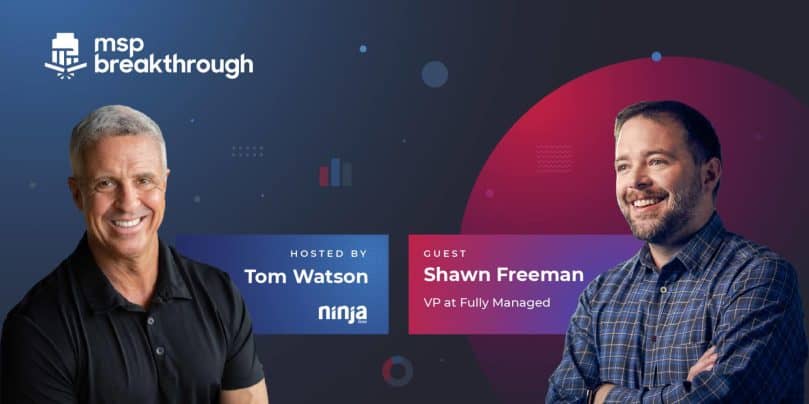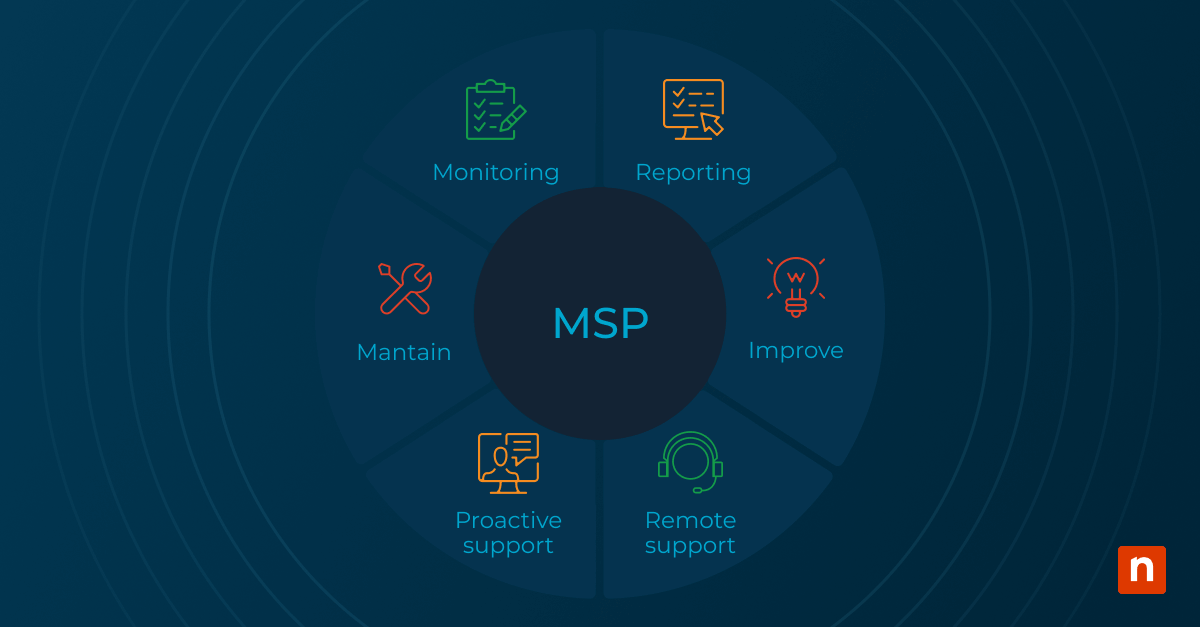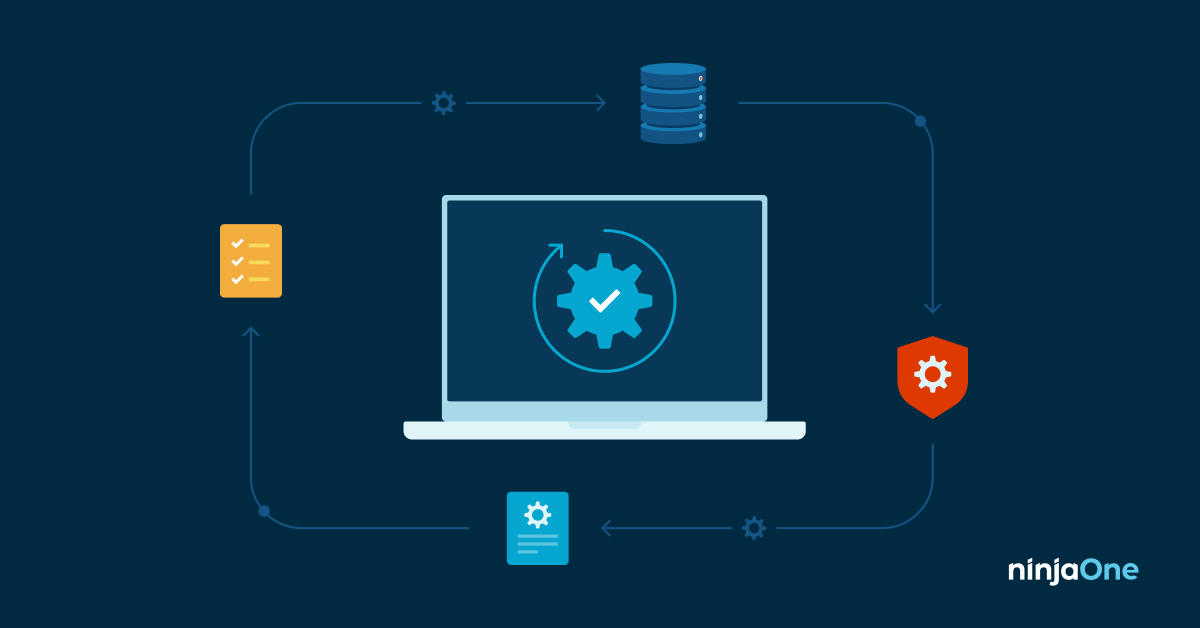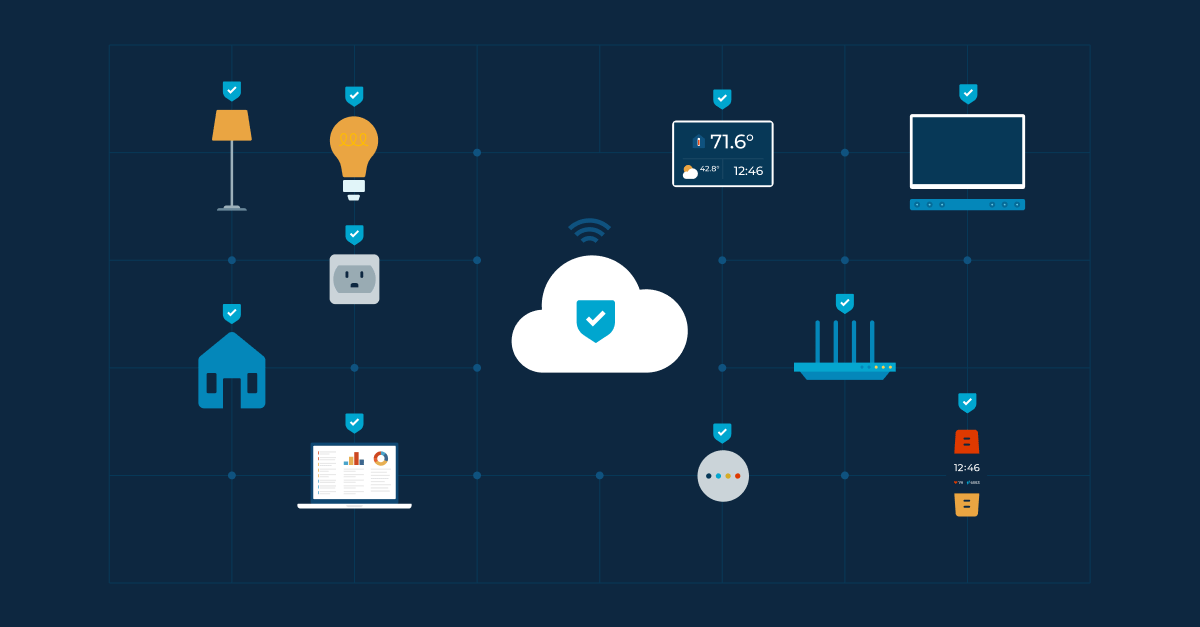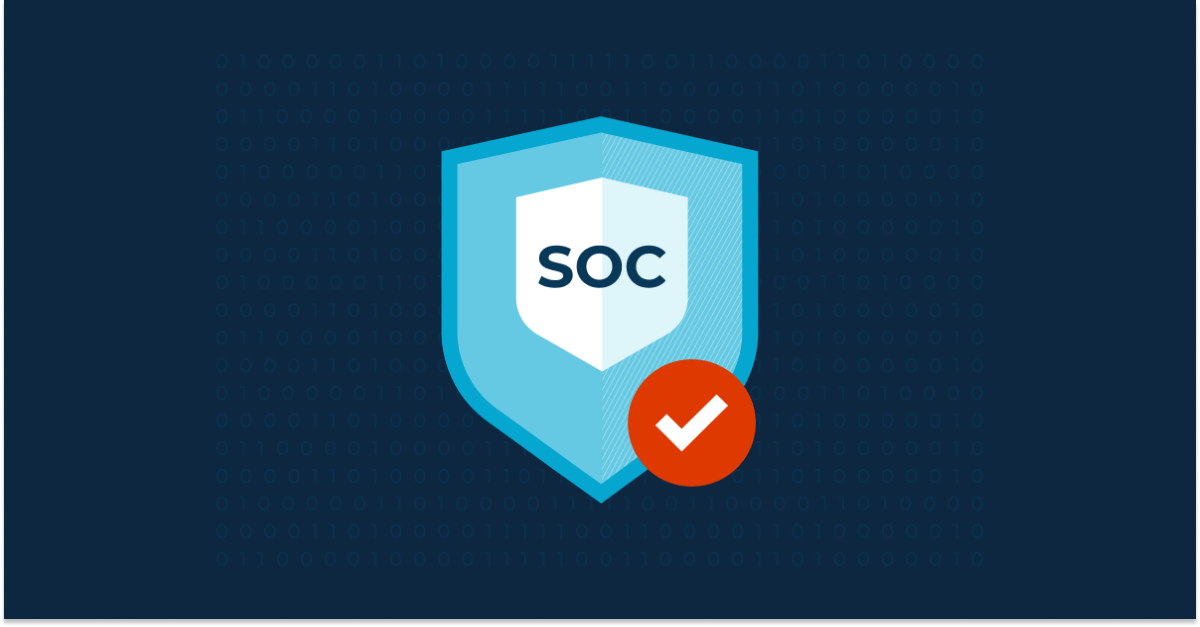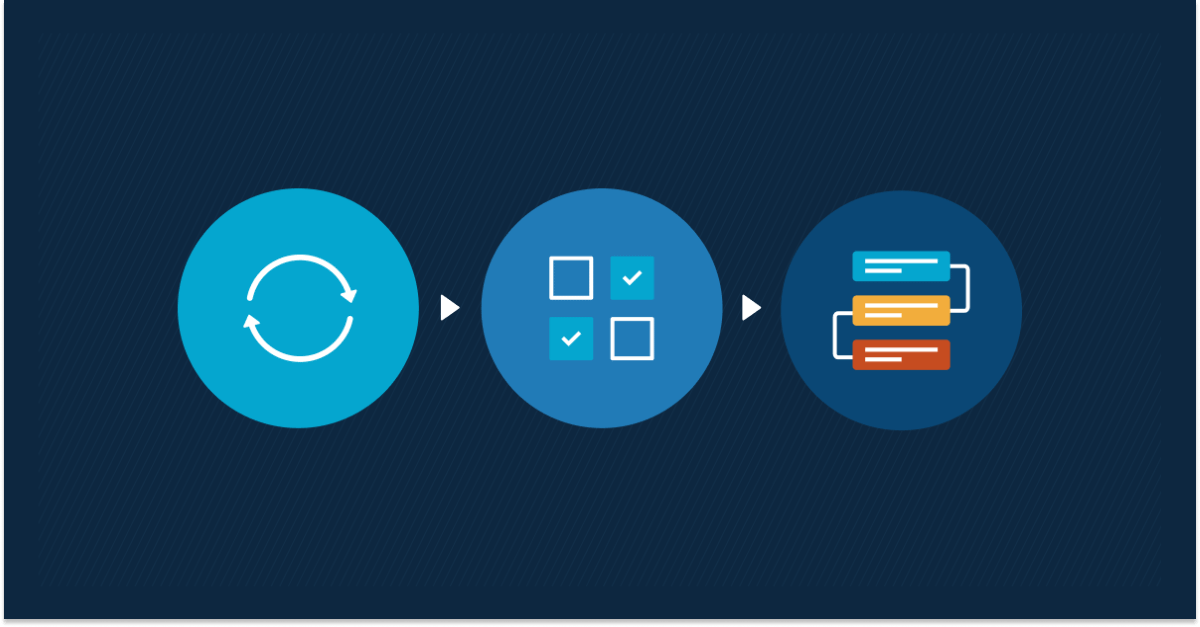Fully Managed VP Shawn Freeman shares the key lessons he learned scaling and guiding his MSP through to a successful exit, and his own transition from the tech guy to the leader his team needed him to be.
It’s not always typical for an MSP owner to stick around following an acquisition, but Shawn Freeman isn’t your typical MSP. Following the sale of TWT Group — the company he founded in 2011 and grew into one of the top IT providers in Calgary — to Fully Managed (a top-50 global MSP), he transitioned into a Vice President role that has him managing a team of 50 across Alberta.
The move speaks to his evolution as a leader and mentor — an evolution that has seen him join the Forbes Technology Council and take on an increasingly influential role in the Alberta tech community, but also an evolution that Shawn freely admits took some helpful encouragement and conscious, strategic effort along the way.
In this episode of MSP Breakthrough, Shawn opens up with NinjaOne’s Jonathan Crowe and NinjaOne Channel Chief Advisor and former MSP owner Tom Watson to discuss productivity, delegation, and the best sales and marketing levers his team pulled to fuel their growth into a multi-million-dollar MSP business.
Scroll through or use the following to jump ahead to each of the topics below:
- Making today’s decisions based on the company you’ll be in 1, 2, 3 years
- Two tricks for forcing yourself to delegate
- A simple but powerful framework for prioritizing
- The sales and marketing activities that fueled our growth
- The power of networks + the one question to end every QBR with
Listen
Like the show? Please consider supporting it with a review. It will help a lot!
You can review/subscribe at either of the following:
Watch
Read (transcript)
Announcer: This is “MSP Breakthrough,” where successful MSP owners walk us through the pivotal moments that put them over the top.
Jonathan: Hey, everyone. I’m Jonathan Crowe, Director of Content and Community at NinjaOne. I’ve got with me Tom Watson, our Channel Chief Advisor. And for this episode, Tom and I actually talked to our guest together. We spoke with Shawn Freeman. He is a former MSP owner of TWT Group, and he’s now currently at Fully Managed, the company that acquired his MSP.
Tom, this is a really great conversation. I really enjoyed this one. What’s something that stuck out to you?
Tom: In particular, Shawn goes into detail about how much the owner of a business’s time is worth. He even tells us how he calculated that, then how he used that number to figure out where to best allocate his hours in the day.
Jonathan: I love how he went about this. Everyone listening, you’re definitely gonna love it too. Let’s check it out.
Making today’s decisions based on the company you’ll be in 1, 2, 3 years
So, Shawn, you’re super active on LinkedIn. I follow you. I’m always really happy to see your posts, because they’re incredibly thoughtful. They’re not just strictly directed towards tech or even being an MSP. You’ve got great stuff, so you’re a good follow. I saw you had a comment recently, when you were replying to a video that Colin Knox put up. Tom just interviewed Colin last week, I think.
Tom: Yes.
Jonathan: And [the video] was going back to the importance of planning out further… and acting bigger than you are ahead of time. So, you mentioned that was maybe a turning point for you, as well, that you started looking at your business in terms of what are we trying to accomplish in the next, not month, not quarter, but year and further out — a year and a half, two years — and what do we need to do to get there? I’m curious about what that transition looked like for you and where it occurred. Were you at a certain revenue point or a certain inflection point with the company?
Shawn: I think, you know, as soon as we started realizing we’re having 50% [growth] years… I said, okay, well, I need to know what employees I need on board in six months. I need to know that today, so that I can work towards that, because, you know, it takes time to hire people. And then everything else falls around that, right? We’re a people business.
And, you know, for me, it was really perspective. You have these self-fulfilling prophesies and you say, “Okay, we want to grow another 50% this year. Okay, what’s that gonna look like?” But then the big picture is, well, in three years, we’re going to be 150% bigger than we are, compounded, right? I really found that was powerful.
“The hard part for a lot of people is to get out of the [day-to-day] business and become the leader and create the vision. Because that’s what you’re there for.”
And also just sharing that with the team, too. I found that was super powerful, because a lot of the times, I found my team didn’t realize that, “Hey, if we keep this up, we went from $8M to $20M in 18 months…” I don’t think that they realized that was going to happen. And so when you put that in front of them, then they’re like, “Oh, okay.” They get amped up. As employees, we all want to know where we’re going, right? What’s my future at this company? How can I contribute?
And then all the decisions you’re making, sometimes, if you stayed at that size of a business, they might not make sense. But if you’re going to be 70% bigger in 18 months, then it totally makes sense. Like paying for tools that are more expensive now that you don’t quite need but you will, right? Stuff like that comes into play. Automation is huge. If you can get your automation done really early, then that scales. So it’s focusing on those types of things.
And just really involving your team. I think that was a huge piece for us. Really giving them ownership made me step back and be the CEO and not be the tech guy, because that’s the hard part for a lot of people is to get out of the business and become the leader and create the vision. Because that’s what you’re there for. You’re there for the vision and support. That’s all you should be doing as a CEO once you get to $10M plus. You shouldn’t be closing tickets or purchasing stuff anymore, or doing invoicing anymore. That should get that off your plate at that time, and having a good team that understands that overall strategy is key.
Two tricks for forcing yourself to delegate
Tom: Well, yes, that’s great. And I can tell you, Jonathan’s sitting there, laughing, because he knows you just hit on a couple of my huge points I like to talk to MSPs about. One is automation and actually doing it. Funny because we just dropped an article about that, about RMM. But additionally, letting go of things and stopping doing things that aren’t going to further your business.
I think we talked about it in our last MSP Live Chat. I was talking about not doing bookkeeping anymore, how I had to make that decision, because that was time intensive. I did not enjoy it, and I wasn’t good at it. But I think a big message is, if you want to scale your business, you have to decide what parts of the business that you can scale and focus on those, and not be doing everything. Can you maybe take us back to that time when you started saying “no” to people and clients and sometimes other managers in your company?
Shawn: Yeah, for sure. You know, we do an annual review of customers and say, “Are they a good fit? Do they meet the values? Are they profitable?” And if any of those is…like if they’re profitable but they don’t meet our values and they’re just a pain and people hate working with them, we’ll get rid of them, even if they’re profitable. It’s amazing, the first time we did that I don’t think the team…I’m pretty sure they thought they were dreaming. and just the response was amazing and the internal morale.
Culture’s another huge piece. Maybe we can touch on that next, but that’s really, again, we’re all people. We all need to be motivated. We all want to enjoy our work, coming to work. We want to have purpose, right? And yeah, just figuring out those things.
“You need to look yourself in the mirror and say, ‘What am I good at? What should somebody else be doing?’ As your business grows, your hourly rate as an owner keeps going up…. Would you pay your bookkeeper $1,000 an hour? Probably not.”
It’s funny. I like to travel. So I always joked —but there’s some truth to it — my travel was almost like a delegation strategy, because when I was away, I couldn’t do work, other than, you know, chatting with the team and help them, right? I couldn’t do bookkeeping and scanning receipts and stuff. So I had to delegate that stuff, but you almost need to look yourself in the mirror and say, “What am I good at? What should somebody else be doing?”
The other thing, too, is just realizing that your time… as your business grows, your hourly rate as an owner, as CEO keeps going up, right? And so, if you’re doing $2M, $3M in revenue, you’re solely responsible for supporting that revenue. So, if you take $3M of revenue, divide it by 2,200 hours in a year that you might work (or maybe 4,000 hours as a CEO), and figure out what your hourly rate is. You’d be surprised. It’s in the several hundreds or maybe thousands of dollars an hour. And would you pay your bookkeeper $1K an hour? Probably not. I think a lot of IT guys are analytical and they’re data focused, and so it’s just another perspective to make it click.
Jonathan: I love those. We’re recording this right after New Year’s and everyone, you know, has the resolutions, right. And resolutions famously fail, because people set goals but they don’t attach them to things that actually make it click and actually establish habits.
I love two things that you just talked about. First of all, I love the figuring out you, as a CEO, your hourly rate and really just keeping that in mind, as everything comes across your desk. Is this worth X amount of dollars an hour? I think that’s great.
The other thing I love is the self-imposed exile. Having that as, like, okay, in your case, you love to travel. You’re going to go on vacations and what a win-win for everybody, right? Frst of all, you get to have time with yourself. You get to unplug. You get to go to an amazing place. And then your team gets to be like, okay, we could just spread our wings a little bit, because Shawn’s away. But forcing yourself to do it is kind of a funny thing of, like, okay, I gotta put in my work. I have to force myself to go to an exotic beach somewhere.
Shawn: It’s funny. I had a joke with my sales person that every time I went away, he’d sign a deal, and I’m pretty it’s still true. I mean, we haven’t traveled all year, but, you know, the last time I did travel, he signed a deal which is kind of funny.
You nailed it on a point there, too — it’s trusting your people. I think that’s the thing a lot of people struggle with too, right? Which, there’s lots of things around that. If you don’t trust them, then why did you hire them? You’ve got to figure that out as a manager.
And I did the quick math. If you’re doing $3M in revenue, your hourly rate of revenue that you’re responsible for is $1,300, more than $1,300 an hour. So it’s significant, and it just keeps growing.
A simple but powerful framework for prioritizing
So the other trick I use is the Eisenhower matrix. I don’t know if you’re familiar with that, but basically, it’s four quadrants, and you can take any task and you can stick it in it.
- Quadrant 1 is “it’s important and it’s urgent,” so you do it and try to make sure less of those happen.
- Quadrant 2 is “it’s important but not urgent” — book it out.
And those are really the only two things you should be doing, because everything else is:
- Quadrant 3: “not important and it’s urgent,” — give it to a team member.
- Quadrant 4: “not important and not urgent,” so don’t do it.
I think if you break everything you’re doing out onto those things, only two of them are for you to do, so the other ones you get rid of, and then only one of them’s actually for you to do right now. So you can get focused on what you need to be doing.
The sales and marketing activities that fueled our growth
Tom: Well, I think we’ve got a few minutes left. I actually have one more. I think there’s another very obvious breakthrough to me which we haven’t covered yet. What I’m hearing, you scaled your MSP very quickly. I mean, you said a $700K increase per year.
Maybe you can take us back to when this business started and how fast that scaling is. And what in particular, for a breakthrough, is what you did in terms of sales in there. Did you hire sales people? What happened? Did you put particular marketing in place? Because when I hear about numbers increasing that fast, I know that it’s not just some organic process. There’s some real thought put into it. And you’re doing something that’s accelerating the business that quickly.
Shawn: For sure. Yes. Our early growth, obviously, as a percentage, was high because if you go from $100,000 to $200,000, that’s 100% growth, right? So you can’t really use percentages all the time. But I would say our first…we were eight-and-a-half years old before we merged with Fully Managed. I would say probably our first four were the slowest growth we had. And then it really clicked.
By that time, we had done a bunch of marketing. We got our name out there. We had some really good clients that knew us and talked about us. A lot of our growth was from referral. So what we did is we just built up a network of people that loved us. And that’s great, right? As an MSP, what more can you ask for? So we did that.
And then, one of the people that was with us, we moved him into an outbound sales position. But a lot of his leads were referrals. They were from our current client base. They were from our network. But, you know, he was hitting his quota within seven months. He was killing it. But it wasn’t like we had somebody [cold] calling. We didn’t do much digital advertising. We had a website and we had a network, because again, it’s a people business.
“I would say probably our first four years were the slowest growth we had. And then it really clicked.”
I always said, IT, lawyers, and accountants — if you’re gonna hire one, if you need to change it, you’re gonna go ask your friends who they use, and you’re probably going to go with that person. So, you know, we set up great partnerships with accounting firms who were clients, and then it’s a partnership, right. They would refer business to us, we would do the same, and we take care of each other, and really turn clients into true partners. And that was huge, I think.
Our outbound sales person wasn’t going door-to-door knocking. He was meeting with people and building relationships and going for lunches and grabbing a beer and stuff like that, that really our small business clients wanted. Maybe you sell differently to enterprise clients, of course, but, you know, the SMB world, they want to know that you want to take care of them, and they want to know they can trust you, and they want to know that you care about them. That was huge.
It takes time to build your brand up in any city. If you have a new brand, it’s going to take you three or four years to get it out there, unless you’re dumping hundreds of thousands of dollars into marketing. Maybe not, but if you want to do that organically.
But then the other thing too, as a business owner, it was my first business. So, you’re obviously super conservative at the beginning, right? You gotta save the money in the bank. You gotta manage financials. You’re hiring people. You want to make sure you don’t need to lay them off. So, it’s obviously, once you get to that point where, okay, you’re making a good salary as the owner, everyone’s making a good salary, you’re putting cash in the bank, your cash flow’s good, then you can start to say, “Okay, how do we reinvest that in marketing and getting our name out there in different events?”
We found events to be super successful, too. You know, partnering up with people like Ninja, and doing events, and bringing clients and prospects into the room, because then, our clients will tell the prospects that we’re awesome. Off we go, and a week later, we sign a proposal, right? So, we found events are really good. Obviously, 2020 kiboshed that marketing tactic for everybody, but hopefully this year, later this year, we can do that.
So, in a nutshell, that’s a bunch of the things we did.
The power of networks + the one question to end every QBR with
Tom: Now, I heard something in particular there that I want our audience to really tune into. It’s that you moved someone into outside sales, and so what I’m seeing here is all MSPs get referrals. What happens is the referrals often…there’s not a dedicated person to follow up on things, and there’s no cadence to do so. There’s no use of the CRM. And by moving someone into that role, you now had someone that that was their job.
Their sole job was to follow up on these things, and that becomes self-fulfilling then. That makes sure those referrals are more likely to close. It makes sure there’s more likely to be more, because you’re timely about it. So, it’s not always necessary to dump a bunch of money into marketing. It’s not always necessary to bang on doors or to do a really aggressive outbound. But it is important that you yourself or you dedicate someone in your company to make sure they’re following up on these leads. Because otherwise, what happens is you get a referral, and you wait two weeks to contact them. Well, you might just have missed your window. They probably talked to someone else.
Shawn: Yeah, because they need to change.
Tom: So that was important.
Shawn: Yeah, when they need to change, they need to change pretty quick, usually.
The other thing too is that we would have our outbound sales person in our weekly meeting with everybody. He would go through his list of leads, and there’s countless amount of times where somebody’s, “Oh, I know somebody there.” And then it’s like boom, done. Even if it was a referral from a client, and they know an employee that’s inside, then off we go, right? We don’t even need to compete because that person’s gonna be like, “Yeah, we’re gonna go with them.”
So we had the CRM to do that and we engaged the whole team, and then they felt part of the whole process. And it wasn’t just… sales wasn’t just a silo, too. That becomes a problem. We still do that today. So, that was huge.
The other thing, too, is… one more trick I’ll give away to everybody is when we were doing our QBRs with our clients, the end question is, “How are we doing? Anything we can improve?” And the final question is, “If you know anybody that can use our help, let me know.” Because a lot of people just don’t think about it. And if you trigger them, if you just put that idea in their head, then they’re like, “Oh, yeah, of course, I love you guys and I want to help you. My friend, yeah, he just started a new accounting company. Let me introduce you.” You know, it’s not a salesy thing. It’s just, “Hey, let us know.”
Announcer: Thanks for listening to “MSP Breakthrough,” brought to you by NinjaOne. If you enjoyed this episode, please subscribe, like, or give us a review.
But wait, there’s more!
Thank you for checking out this episode and hope you enjoyed it. We’ve got a killer lineup of fantastic guests for future episodes, so make sure you don’t miss their breakthroughs by picking a subscribe option below:
If you liked this episode, please consider giving us a review. We’d love the feedback and really appreciate your support!

